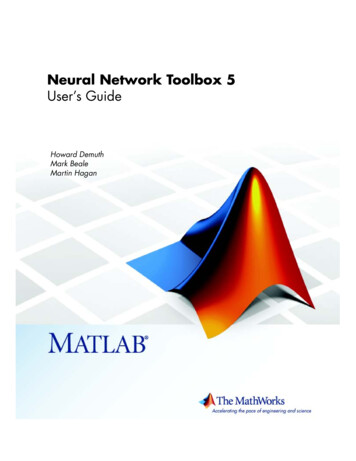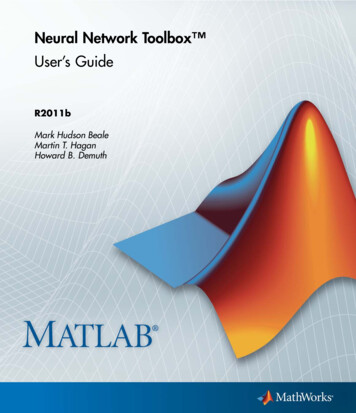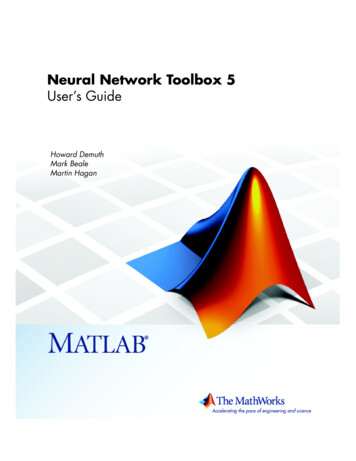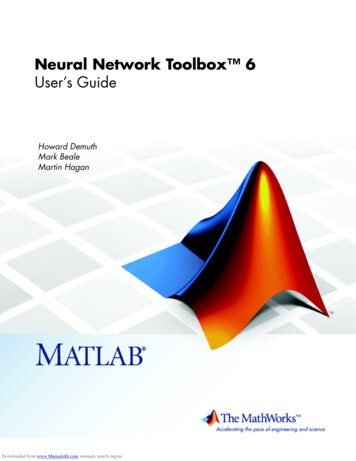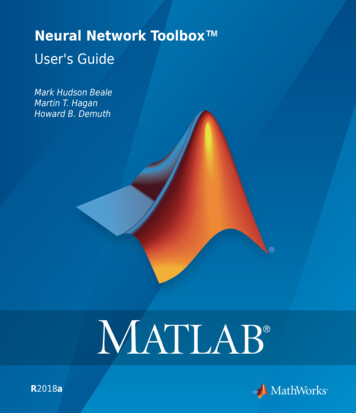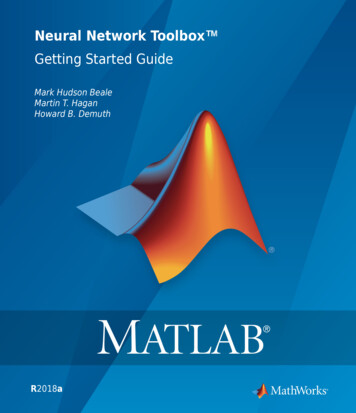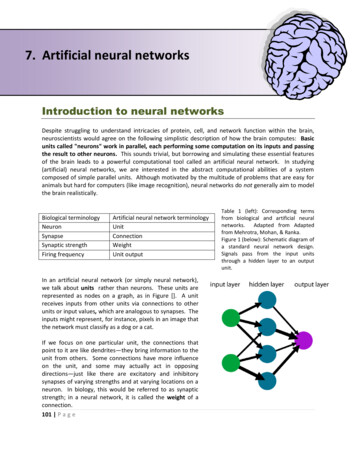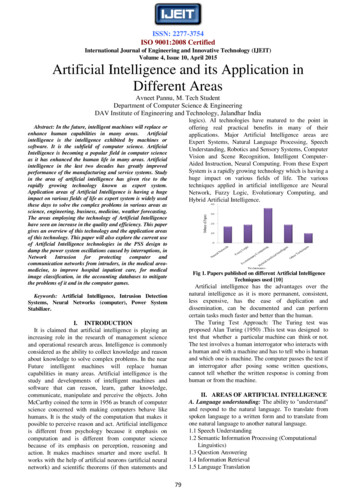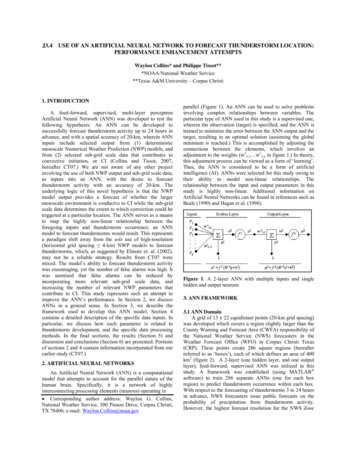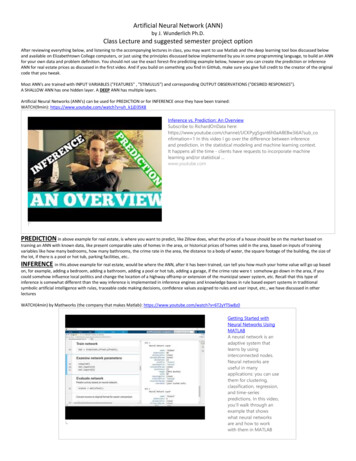
Transcription
Artificial Neural Network (ANN)by J. Wunderlich Ph.D.Class Lecture and suggested semester project optionAfter reviewing everything below, and listening to the accompanying lectures in class, you may want to use Matlab and the deep learning tool box discussed belowand available on Elizabethtown College computers, or just using the principles discussed below implemented by you in some programming language, to build an ANNfor your own data and problem definition. You should not use the exact forest-fire predicting example below, however you can create the prediction or inferenceANN for real estate prices as discussed in the first video. And if you build on something you find in GitHub, make sure you give full credit to the creator of the originalcode that you tweak.Most ANN's are trained with INPUT VARIABLES ("FEATURES" , "STIMULUS") and corresponding OUTPUT OBSERVATIONS ("DESIRED RESPONSES").A SHALLOW ANN has one hidden layer. A DEEP ANN has multiple layers.Artificial Neural Networks (ANN's) can be used for PREDICTION or for INFERENCE once they have been trained:WATCH(9min): https://www.youtube.com/watch?v uh k1jD35K8Inference vs. Prediction: An OverviewSubscribe to RichardOnData 0aA8EBw3i6A?sub confirmation 1 In this video I go over the difference between inferenceand prediction, in the statistical modeling and machine learning context.It happens all the time - clients have requests to incorporate machinelearning and/or statistical .www.youtube.comPREDICTION in above example for real estate, is where you want to predict, like Zillow does, what the price of a house should be on the market based ontraining an ANN with known data, like present comparable sales of homes in the area, or historical prices of homes sold in the area, based on inputs of trainingvariables like how many bedrooms, how many bathrooms, the crime rate in the area, the distance to a body of water, the square footage of the building, the size ofthe lot, if there is a pool or hot tub, parking facilities, etc.INFERENCE in this above example for real estate, would be where the ANN, after it has been trained, can tell you how much your home value will go up basedon, for example, adding a bedroom, adding a bathroom, adding a pool or hot tub, adding a garage, if the crime rate were t somehow go down in the area, if youcould somehow influence local politics and change the location of a highway offramp or extension of the municipal sewer system, etc. Recall that this type ofinference is somewhat different than the way inference is implemented in inference engines and knowledge bases in rule based expert systems in traditionalsymbolic artificial intelligence with rules, traceable code making decisions, confidence values assigned to rules and user input, etc., we have discussed in otherlecturesWATCH(4min) by Mathworks (the company that makes Matlab): https://www.youtube.com/watch?v 6T2yYTSw8z0Getting Started withNeural Networks UsingMATLABA neural network is anadaptive system thatlearns by usinginterconnected nodes.Neural networks areuseful in manyapplications: you can usethem for clustering,classification, regression,and time-seriespredictions. In this video,you’ll walk through anexample that showswhat neural networksare and how to workwith them in MATLAB
The following example is for PREDICTING when forest fires will be likely (i.e., the Percentage of a chance of fire), based on a training set of 1,500 weatherdata, separated into three different variables: temperature, humidity, and wind speed.WATCH (81min, but only watch first 62min): https://www.youtube.com/watch?v xOzh6PMk21ITraining an Artificial NeuralNetwork with Matlab –Machine Learning forEngineersThis video is part of the\"Artificial Intelligence andMachine Learning forEngineers\" course offered atthe University of California,Los Angeles (UCLA). Thiscourse introduces ML/AItheory and applications thatare relevant to engineering,with a focus on practicalmachine learning for civilengineering. This tutorialillustrates how to use .www.youtube.comLoad the raw weather data from the fire.csv file (a Comma-Separated-Values file), into a matrix. And for this example, all the input data is originally formatted incolumns, but will later need to be converted into rows to fit the inpu format desired by Matlab functions. See Matlab help for function tlab/ref/readmatrix.htmlAlso define a matrix of inputs "x" with its all the rows, from beginning to the end, designated in the "x data(:,1:3);" by the ":" by itself, with nothing on either side ofthe ":", and the columns of this matrix named “data” is being defined by the "1:3" for the three input variables. And the output Y variable (a vector) comes from thefourth column of the input data. The variable “m” is the length of the vector y, which is the number of desired output observations (responses) in this original dataset, for later use.:
Before training the ANN, it’s best to PRECONDITION both the input and output data.Let’s first look at CONDITIONING THE OUTPUT: First, a histogram (bar chart) is made to look at the raw y data, with “10” in the Matlab function indicating to group the data in “bins” of ten Data points: So we see above in the histogram that the bar on the left is very high, indicating that there are many combinations of the three input variables that resultin close to 0% chance of a fire; however we see on the far right that there are a number of combinations of input variables that can almost guarantee afire. This kind of distribution of results is very much skewed to the left and therefore the output would be better if a log form of it was created. So, below, we transform "y" onto a LOG scale, and add one (“ 1”) so that there is no error if the value of the original "y" is zero -- i.e., log(0) is an error. Alogarithmic scale is a nonlinear scale used when analyzing a large range of quantities. Instead of increasing in equal increments, each interval is increasedby a factor of the base of the logarithm; Typically, base ten: And now we see a more uniformly distributed distribution of the raw output data, which is a better form of the data for the ANN to learn.Then look at CONDITIONING THE INPUTS: We NORMALIZE the input data below, for each input variable, by dividing all the inputs of the variable, by the range of values of all of the inputs of thatvariable, from minimum to maximum (i.e., the Max - the Min). This is done so each of them contributes the same relative range of values to the stimulus ofthe neural network, otherwise the variable with the largest magnitude could contribute a disproportionate amount.And then do histogram (a bar chart), and x,y plot of each of the three input variables, to visualize the normalized inputs, and LOG-transformed output:andto see Normalized TEMPERATURE inputs (inCelcius), with no clear visual relationship between x and y showing on the plot. (the 'o' just says plot little circles):andandto see Normalized RELATIVE HUMIDITY inputs (inPercent), with somewhat of an inverse relationship showing between x and y (i.e., lack of Relative humidity causing a fire) on the plot:andbetween x and y showing on the plot:andto see Normalized WINDSPEED inputs (in KPH), with no clear visual relationship
TRAIN the ANN:Although training sets are typically listed with columns of INPUT VARIABLES ("FEATURES" , "STIMULUS") and a column of OUTPUT OBSERVATIONS ("DESIREDRESPONSES"), Matlab likes everything in rows, so you need to take the transpose of the matrix that contains all of the inputs so that everything is rotated 90 intorows of inputs within the resulting transpose matrix, the single quote ( ' ) after the variable is Matlab's way of transposing a matrix:The ANN architecture defaults to one hidden layer, and then in this example the user is specifying that there are 10 neurons in the hidden layer (even though that isthe default number). However, if you were to instead do:you could pick different training methods, like for example "momentum" where the ANN will drive faster towards Minima on the error surface based on recentprevious learning steps.Also shown above, breaking the initial data into three sets of data: The TRAINING SET is used to change the weights within the neural network as it learns to compromise such that it satisfies all of the stimulus/desiredresponse pairs of the training set VALADATION SET is used to optimize hyperparameters (for example the number of hidden layers and the number of neurons in each in their). The defaultneural network has one hidden layer with 10 neurons. This is a SHALLOW ANN since it only has one hidden layer. A DEEP ANN has multiple layers. The TEST SET Which eventually will be taken from the training set, not the validation set, since that was tuned exactly for optimization of thearchitecture."[net, tr] train(net, xt , yt);" above will yield a new "net" function, a trained network! . that will be created by the "train" function, with the "tr" being a returnedTraining Record, including: a variable "trainInd" (see below) which is a vector of 350 elements (Indicies) from the 500 original elements in the training set i.e. the 70% specifiedabove in "net.divideParam.trainRatio 70/100;" that tells this Matlab toolbox program to randomly pick 70% of the original raw data set to be used fortraining the ANN. a variable "valInd" (see below) which is a vector of 150 elements (Indicies) from the 500 original elements in the training set i.e. the 30% specified abovein "net.divideParam.valRatio 30/100;" that tells this Matlab toolbox program to randomly pick 30% of the original raw data set to be used forvalidating(optiizing the architecture) of the ANN.The following window will open when the "train" function is executed:
See more on Matlab training functions, including a way to use GPU's instead of CPU's,here: twork.train.html#d123e185236Now that the ANN has been trained using the TRAINING SET (where here it is a subset of all of the original data set), we can access the performance of this ANN bycomparing the actual outputs of the trained ANN for all of the original data set, to all of the outputs listed in the initial data set. This is theRoot MEAN SQUARED ERROR (RME )that is being minimized as the ANN learns.This is calculated by taking the square root of the total of each of the differences squared, one by one, between what the trained neural network outputs "yTrain",and the original desired outputs "yTrainTrue" of everything in the training set, evaluating one example at a time, which is what the ". 2" does:But recall that we had transformed the output using Log(y 1) of the original data, and trained the ANN with that, so now we should undo this when comparing theprediction outputs to the desired output. This is done by raising these outfits as an exponent (in base 10) and then subtracting one:So therefore this neural network can predict the percentage chance of fire with only an 8.4265% ERROR.And when we do the same thing using the validation set, we see an 8.5969% ERROR:
Now redo everything while making the number of neurons in the hidden layer avariable that is optimized:where "rmse train(i)" and "rmse val(i)" are vectors created for plots.Watch the architecture and parameters change as you execute the above code from time index 55:50 to 55:27:And you will see that there is UNDERFITTING when there is not enough neurons in the hidden layer, and OVERFITTING there are too many:In the graph above (top curve is for validation set) you can see that both the validation set and training set have too high of an error (both 10%) when there are only acouple neurons in the hidden there, and then the error for both of them decreases when there are approximately a half dozen neurons in the hidden layer (the xaxis);and then when the number of hidden neurons gets to 30 or 40, the difference in validation set error becomes higher than the training set which indicatesOVERFITTING, and therefore the network will begin to not be able to predict well when presented with new stimulus input that is not part of the training set.And so, for this example it would be better to have an extremely simple architecture with only a few hidden neurons than to have way too many such that the ANNloses its ability to accurately predict when presented new never-seen-before stimulus.For this architecture the best number of neurons in the hidden layer is seven:
See more on overfitting here: -underfitting-with-machine-learning-algorithms/And why we train with noise here: s-annoying-1bd5f0f240fNow go back and plug the number 7 into the code above:To see improved performance.For this course stop at time 1:02 in the video.
Artificial Neural Network (ANN) by J. Wunderlich Ph.D. Class Lecture and suggested semester project option After reviewing everything below, and listening to the accompanying lectures in class, you may want to use Matlab and th
